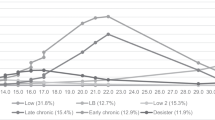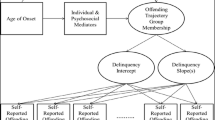Abstract
Arrest rates among the population of youth who have been served in child mental health systems are known to be high during adolescence and young adulthood, but individual longitudinal patterns have not been examined. The present study used developmental trajectory modeling, a contemporary method used widely in criminology, to examine clusters of individual criminal justice involvement patterns at ages 8 through 25, from database records of 131 individuals in public adolescent mental health services. Three groups of particular concern emerged: one with increasingly high offense rates and two with moderate to high violent offense rates that did not desist. Offense patterns in these groups indicate that early intervention should occur before age 15. Some risk factors were identified. Peak offending for most groups occurred between ages 18 and 20. Implications of these findings for mental health services during the transition to adulthood are offered.
Similar content being viewed by others
References
Davis M, Vander Stoep A. The transition to adulthood among children and adolescents who have serious emotional disturbance. Part I: developmental transitions.Journal of Mental Health Administration. 1997;24:400–427.
Silver S, Unger K, Friedman R.Transition to Young Adulthood Among Youth With Emotional Disturbance. Tampa, Fla: University of South Florida, Florida Mental Health Institute, Research & Training Center for Children's Mental Health; 1994. Report No. 839.
Bryant E, Rivard J, Cowan T, et al. Frequency and correlates of juvenile justice system involvement among children and adolescents with severe emotional disturbance. In: Liberton C, Kutash K, Friedman R, eds.The 7th Annual Conference Proceedings, A System of Care for Children's Mental Health: Expanding the Research Base. Tampa, Fla: Research & Training Center for Children's Mental Health, Florida Mental Health Institute; 1995:295–302.
Davis M. Corrections involvement of adolescents with SED: patterns into adulthood. In: Liberton C, Kutash K, Friedman R, eds.The 14th Annual Research Conference Proceedings, A System of Care for Children's Mental Health: Expanding the Research Base. Tampa, Fla: Research & Training Center for Children's Mental Health; 2002:149–152.
Valdes K, Williamson C, Wagner M.The National Longitudinal Transition Study of Special Education Students. Youth Categorized as Emotionally Disturbed. Statistical Almanac. Vol 3. Menlo Park, Calif: SRI International; 1990.
Vander Stoep A, Evens C, Taub J. Risk of juvenile justice system referral among children in a public mental health system.Journal of Mental Health Administration. 1997;24(pt1):428–442.
Blumstein A, Cohen J, Roth JA, et al.Criminal Careers and Career Criminals. Washington, DC: National Academy Press; 1986:2.
Elliott D, Ageton S, Huizinga D et al.The Prevalence and Incidence of Delinquent Behavior. Boulder, Colo: Behavioral Research Institute; 1983. The National Youth Survey, Report No. (26) 1976–1980.
Farrington DP, Gallagher B, Morley L, et al. Unemployment, school leaving, and crime.British Journal of Criminology. 1986;26(4):335–356.
Wolfgang M, Thornberry T, Figlio R.From Boy to Man, From Delinquency to Crime. Chicago, Ill: University of Chicago Press; 1987.
Vander Stoep A, Beresford SA, Weiss NS, et all Community-based study of the transition to adulthood for adolescents with psychiatric disorder.American Journal of Epidemiology. 2000;152:352–362.
Evens C, Vander Stoep A. Risk factors for juvenile justice system referral among children in a public mental health system.The Journal of Mental Health Administration. 1997;24(pt2):443–455.
Wagner M. Outcomes for youths with serious emotional disturbance in secondary school and early adulthood.The Future of Children: Critical Issues for Children and Youths. 1995;5:90–112.
Rosenblatt JA, Rosenblatt A, Biggs EE. Criminal behavior and emotional disorder: comparing youth served by the mental health and juvenile justice systems.Journal of Behavioral Health Services & Research. 2000;27(2):227–237.
Blumstein A, Cohen J, Farrington DP. Criminal career research: its value for criminology.Criminology. 1988;26:1–36.
Hagan J, Palloni A. Crimes as social events in the life course: reconceiving a criminal controversy.Criminology. 1988;26:87–100.
Wolfgang ME, Figlio RM, Sellin T.Delinquency in a Birth Cohort. Chicago, Ill: University of Chicago Press; 1972.
Nagin D. Analyzing developmental trajectories: a semiparametric, group-based approach.Psychological Methods. 1999;4:139–157.
Laub JH, Nagin DS, Sampson RJ. Trajectories of change in criminal offending: good marriages and the desistance process.American Sociological Review. 1998;63:225–238.
Nagin D, Land K. Age, criminal careers, and population heterogeneity: specification and estimation of a nonparametric, mixed Poisson model.Criminology. 1993;31:327–362.
Nagin D, Farrington D, Moffitt T. Life-course trajectories of different types of offenders.Criminology. 1995;33:111–139.
Piquero A, Blumstein A, Brame R, et al. Assessing the impact of exposure time and incapacitation on longitudinal trajectories of criminal offending.Journal of Adolescent Research. 2001;16:54–74.
Chung IJ, Hawkins JD, Gilchrist LD, et al. Identifying and predicting offending trajectories among poor children.Social Service Review. 2002;76:663–685.
D'Unger AV, Land KC, McCall PL. Sex differences in age patterns of delinquent/criminal careers: results from Poisson latent class analysis of the Philadelphia Cohort Study.Journal of Quantitative Criminology. 2002;18(4):349–375.
D'Unger AV, Land KC, McCall PL, et al. How many latent classes of delinquent/criminal careers? Results from mixed Poisson regression analyses.American Journal of Sociology. 1998;103(6):1593–1630.
McDermott S, Nagin DS. Same or different? Comparing offender groups and covariates over time.Sociological Methods & Research. 2001;29(3):282–318.
Jones BL, Nagin DS, Roeder K. A SAS procedure based on mixture models for estimating developmental trajectories.Sociological Methods & Research. 2001;29:374–393.
Hawkins RP, Almeida MC, Fabry B, et al. A scale to measure restrictiveness of living environments for troubled children and youths.Hospital and Community Psychiatry. 1992;43:54–58.
Moffitt TE. Adolescence-limited and life-course-persistent antisocial behavior: a developmental taxonomy.Psychological Review. 1993;100:674–701.
Patterson GR, Reid JB, Dishion TJ.Antisocial Boys: A Social Interactional Approach. Eugene, Ore: Castalia; 1992.
Laub JH, Sampson RJ. Turning points in the life course: why change matters to the study of crime.Criminology. 1993;31(3):301–325.
Sampson R, Laub J.Crime in the Making: Pathways and Turning Points Through Life. Cambridge, Mass: Harvard University Press; 1993.
Britt CI. The measurement of specialization and escalation in the criminal career: an alternative modeling strategy.Journal of Quantitative Criminology. 1996;12(2):193–222.
Elliott DS, Menard S. Delinquent friends and delinquent behavior: temporal and developmental patterns. In: Hawkins D, ed.Delinquency and Crime: Current Theories. Cambridge Criminology Series. New York, NY: Cambridge University Press; 1996:28–67.
Thornberry TP. Toward an interactional theory of delinquency.Criminology. 1987;25:863–891.
Patterson GR.Coercive Family Process. Eugene, Ore: Castalia; 1982.
Lipsey MW, Wilson DB. Effective intervention for serious juvenile offenders: a synthesis of research. In: Loeber R, Farrington D, eds.Serious and Violent Juvenile Offenders: Risk Factors and Successful Interventions. Thousand Oaks, Calif: Sage; 1998:313–345.
Henggeler S, Borduin CM. Multisystemic treatment of serious juvenile offenders and their families. In: Schwartz IM, AuClaire P, eds.Home-based Services for Troubled Children. Lincoln, Nebr: University of Nebraska Press; 1995:113–130.
Moore KJ, Sprengelmeyer PG, Chamberlain P. Community-based treatment for adjudicated delinquents: the Oregon Social Learning Center's “Monitor” Multidimensional Treatment Foster Care program.Residential Treatment for Children & Youth. 2001;18(3):87–97.
Steadman HJ, Deane MW, Morrissey JP, et al. A SAMHSA research initiative assessing the effectiveness of jail diversion programs for mentally ill persons.Psychiatric Services. 1999;50:1620–1623.
Grisso T.Forensic Evaluation of Juveniles. Sarasota, Fla: Professional Resource Press; 1998.
Cohen P, Hesselbart C. Demographic factors in the use of children's mental health services.American Journal of Public Health. 1993;2:49–52.
Davis M. Mental health service utilization by transitional youth. Paper presented at: The 8th Annual Research Conference, A System of Care for Children's Mental Health: Expanding the Research Base, University of Florida, Research & Training Center for Children's Mental Health; March 3–5, 1995; Tampa, Fla.
Silver S. How to promote (and not interfere with) effective transition. Paper presented at: The 8th Annual Research Conference, A System of Care for Children's Mental Health: Expanding the Research Base, University of South Florida, Research & Training Center for Children's Mental Health; March 3–5, 1995; Tampa, Fla.
Davis, M.Transition Supports To Help Adolescents in Mental Health Services. Alexandria, Va: National Association of State Mental Health Program Directors; 2001.
Clark HB, Pschorr O, Wells P, et al. Transition into community roles for young people with emotional and/or behavioral difficulties: coordinated practices and collaborative systems. In: Cheney D, ed.Transition of Students With Emotional or Behavioral Difficulties from School to Communities. Washington, DC: Council for Exceptional Children. In press.
Author information
Authors and Affiliations
Corresponding author
Rights and permissions
About this article
Cite this article
Davis, M., Banks, S., Fisher, W. et al. Longitudinal patterns of offending during the transition to adulthood in youth from the mental health system. The Journal of Behavioral Health Services & Research 31, 351–366 (2004). https://doi.org/10.1007/BF02287689
Issue Date:
DOI: https://doi.org/10.1007/BF02287689




